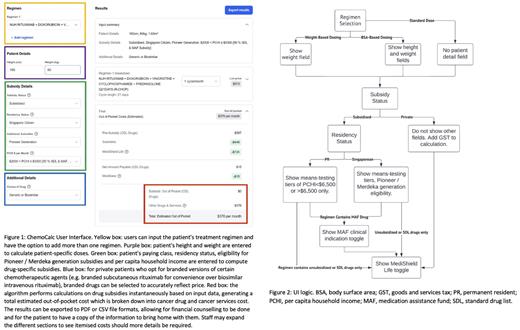Introduction
Public healthcare in Singapore is funded by a combination of subsidies, insurance, which includes national basic coverage (MediShield, MSL) and optional private coverage, pensions (MediSave, MSV) and out of pocket (OOP) costs. In Sep 2022, spiraling cancer costs led to a shift in national policy with the introduction of a Cancer Drug List (CDL) of cost-effective treatments. OOP costs are now determined by multiple factors such as subsidy status, financial resources, insurance claim limits, residency status, drug subsidy tier, therapeutic indication, dose and cost. To simplify this complex manual process, we developed ChemoCalc, a digital calculator for individualized OOP estimates. We hypothesize that it will increase OOP cost estimate accuracy, improve efficiency and have high uptake.
Methods
The study was performed in a Singapore tertiary cancer center. ChemoCalc was developed with a multi-disciplinary team comprising physicians, pharmacists, operations administrators, patient service associates and medical social workers. Data sources were consolidated and hierarchical logic determined for calculating regimen and patient-specific OOP cost. Data sources included the CDL, hospital formulary, chemotherapy protocols, chemotherapy facility fees and various national subsidy schemes. These were encoded into an algorithm by a third-party developer. The user interface and experience (UI/UX) was envisioned by the team with iterations based on feasibility testing. FCs were trained on using ChemoCalc and data was collected pre and post-ChemoCalc implementation.
Feasibility outcomes were demand, acceptability, practicality and integration (the extent to which ChemoCalc could be deployed in a secure hospital IT environment). These were assessed through employee focus groups (FG). Reporting officers were not present during the FG.
Implementation outcomes were adoption (percentage of eligible users using ChemoCalc for FC), engagement (percentage of returning users), efficiency (median time taken to perform FC) and accuracy (percentage of bills which are within ±10% of the FC estimate). For accuracy, 10 bills were randomly selected each month and compared against the pre-treatment FC.
Results
Prior to the development of ChemoCalc, the demand for automated FC was identified through employee engagement. ChemoCalc (Figure 1) was developed and iterated from Aug - Sep 2022. Feasibility assessment identified that simplicity underscored a good UI/UX. To reduce UI clutter and improve ease-of-use, an algorithm was encoded to ensure that only variables relevant to a particular regimen need to be entered (Figure 2). All data fields were accessible via the hospital electronic medical record. The final version of ChemoCalc was deemed acceptable and practical by FG. It was integrated into the hospital environment seamlessly and accessible from all hospital computers and personal mobile devices.
Data collection for implementation outcomes took place from 1 Oct 2022 to 31 Mar 2023. ChemoCalc was used by 72 different members of staff from all job groups. On average, the prices of 2,484 regimens (mean 11 regimens per patient) were generated each month, with a total of 17,385 price estimates generated. 91% of price estimates were for subsidized patients and 9% for private patients. For staff performing FC, the adoption and engagement rate was 100%.
ChemoCalc improved efficiency for the FC process with an accuracy of 95% (baseline 35%, 270% increase). Time spent computing OOP reduced from a median of 8 min (range 4.5 - 13) to 44 seconds (range 15 - 20) for simple regimens, and 23 min (range 15.5 - 44) to 1 min (range 0.3 - 1.3) for complex regimens respectively. Due to the convenience and simplicity, there was 100% uptake for pre-treatment FC, as staff have been able to process more FC requests and spend more time addressing patients' financial concerns. It has also allowed patients to compare costs of different treatment regimens.
Conclusion
The implementation of ChemoCalc was successful with 100% adoption rate and significantly improved efficiency and accuracy. ChemoCalc's algorithm can easily be adjusted to accommodate country- or institution-specific reimbursements for implementation elsewhere. Further studies are required to investigate if pre-treatment FC addresses financial toxicity or influences healthcare costs.
Disclosures
No relevant conflicts of interest to declare.


